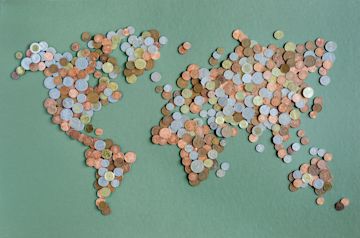What are interest rates? The basics explained

Interest rates definition
An interest rate is the amount a lender charges someone to borrow money—or any asset really. Banks can also offer interest rates on your savings, to encourage you to bank with them and help you grow your money. Imagine you’d like to borrow some money. The person lending you that money might charge a percentage of the amount you borrow. It’s sort of like a rental charge, as you would pay to rent a car or property. That percentage is the interest rate, often called an annual percentage rate or APR.How do interest rates work?
Whether you’re looking to open a savings account or take out a credit card, interest rates work the same in both instances. There are two ways the interest rate is agreed upon—as a fixed or variable rate. Fixed interest rates stay the same throughout the agreement. A variable interest rate will rise or fall with the ‘prime rate’—the one set by centralized banks. The two types of interest to know about are ‘simple interest’ and ‘compound interest’.Simple interest
Simple interest is based on the principal amount—that is, the original amount of money being loaned or deposited into a savings account. Simple interest is often applied to car loans, short-term loans, and sometimes mortgages. To calculate how much you could end up paying for a loan with simple interest, you can simply multiply the principal amount by the daily interest rate and the number of days until the end of your loan period.
Compound interest
Compound interest is based on the principal amount, plus any interest raised during an agreed period. This means you’ll be paying interest on interest. The amount owed will grow quicker than if it were simple interest. You often see compound interest applied to credit cards. It’s best to pay the interest of each compounding period—the time between each time interest is compounded—in full when possible, to avoid the amount you owe from growing quickly.

When do interest rates go down?
Supply and demand play a big role in the ups and downs of interest rates. Take the recent pandemic as a prime example—with so much uncertainty, people and businesses were hesitant to borrow money, so interest rates fell. Low economic growth and inflation rates can drive down interest rates. Interest rates may also fall lower when banks have more money to lend or invest—as this increases supply, your savings will make less money due to lower interest rates, but the cost of borrowing goes down.
When will interest rates go up?
Interest rates are always changing. So if you’re considering a loan, it’s good to keep an eye on how interest rates are fluctuating. When the economy is experiencing growth and inflation, any money lent by banks today is worth less tomorrow. This is because the value of money decreases when inflation occurs, like how a carton of milk costs much more than it did 10 years ago. In this situation, banks are likely to increase interest rates to counteract their losses over time.
Why do lenders charge interest rates?
Organizations charge interest rates on loans to compensate themselves for not being able to use that amount of money for something else. For example, if the lender had invested the money elsewhere, it could have grown in value. So, by charging interest, they are still making that money generate value and grow. The lender also takes on the risk of the borrower not being able to pay back the loan, known as ‘defaulting’. Charging interest helps the lender to counter the risk of defaulting.Why do banks offer interest rates on savings?
Banks pay interest on savings to encourage people to deposit their money. In turn, the bank can then invest and grow the deposited amount. Having lots of savings deposited in a bank also increases the amount that the bank can offer as loans to their customers. When choosing a savings account, look for deposit protection—this will protect your money even if a bank were to go bankrupt. At N26, your money is protected up to €100,000, thanks to the German Deposit Protection Scheme.What are interest rates today?




